Acura MDX 2004 Workshop Manual
Manufacturer: ACURA, Model Year: 2004, Model line: MDX, Model: Acura MDX 2004Pages: 284, PDF Size: 3.92 MB
Page 51 of 284
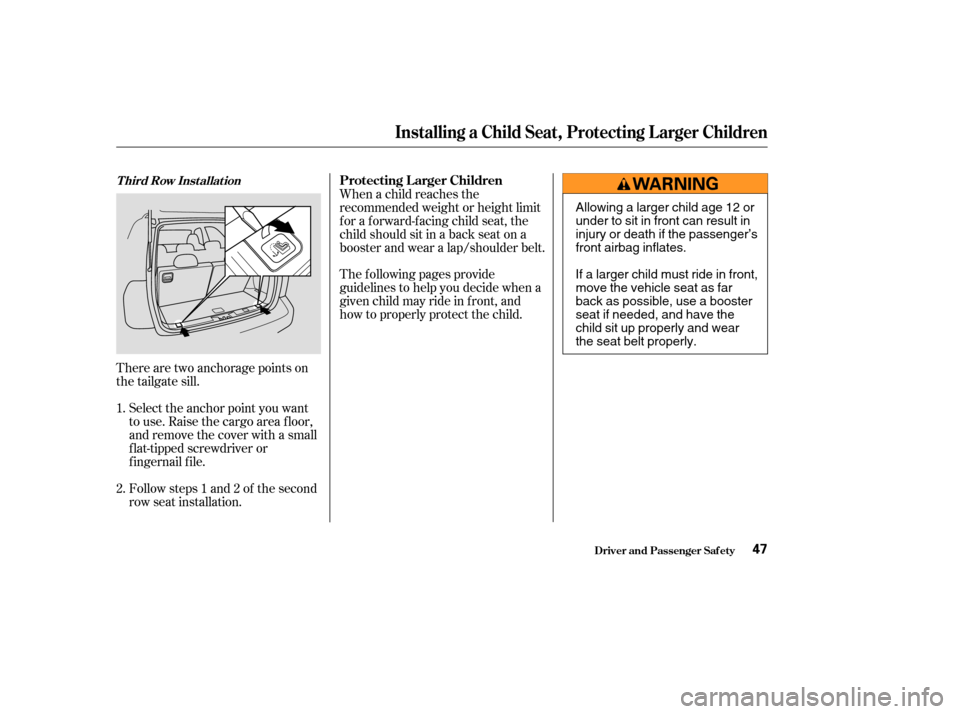
There are two anchorage points on
the tailgate sill.Select the anchor point you want
to use. Raise the cargo area f loor,
and remove the cover with a small
f lat-tipped screwdriver or
f ingernail f ile.
Followsteps1and2of thesecond
row seat installation. When a child reaches the
recommended weight or height limit
for a forward-facing child seat, the
child should sit in a back seat on a
booster and wear a lap/shoulder belt.
The f ollowing pages provide
guidelines to help you decide when a
given child may ride in f ront, and
how to properly protect the child.
2. 1.
Installing a Child Seat, Protecting L arger Children
Driver and Passenger Saf ety
T hird Row Inst allat ionProtecting L arger Children
47
Allowing a larger child age 12 or
under to sit in front can result in
injury or death if the passenger’s
front airbag inflates.
If a larger child must ride in front,
move the vehicle seat as far
back as possible, use a booster
seat if needed, and have the
child sit up properly and wear
the seat belt properly.
Page 52 of 284

To determine if a lap/shoulder belt
properly f its a child, have the child
put on the seat belt, then ask
yourself :Does the child sit all the way back
against the seat?
Do the child’s knees bend
comf ortably over the edge of the
seat? Does the shoulder belt cross
between the child’s neck and arm?
Is the lap part of the belt as low as
possible, touching the child’s
thighs?
Will the child be able to stay
seated like this f or the whole trip?
If you answer yes to all these
questions, the child is ready to wear
the lap/shoulder belt correctly. If
you answer no to any question, the
child needs to ride on a booster seat. A child who has outgrown a f orward- f acing child seat should ride in a
back seat and use a booster seat
until the lap/shoulder belt f its them
properly without the booster.
1.
2. 3.
4.
5.
Protecting L arger Children
Driver and Passenger Saf ety
Checking Seat Belt Fit
Using a Booster Seat
48
Page 53 of 284

Some states also require children to
use a booster until they reach a
given age or weight (e.g., 6 years or
60lbs).Besuretocheckcurrent
laws in the state or states where you
intend to drive.
Booster seats can be high-back or
low-back. Whichever style you select,
make sure the booster meets f ederal
saf ety standards (see page ) and
that you f ollow the booster seat
maker’s instructions.
If a child who uses a booster must
ride in f ront, move the vehicle seat
as far to the rear as possible, and be
sure the child is wearing the seat
belt properly.
A child may continue using a booster
seat until the tops of their ears are
even with the top of the vehicle’s or
booster’s seat-back. A child of this
height should be tall enough to use
the lap/shoulder belt without abooster.
Even then, the child may still need to
use a booster seat. Note that some
states now require children to use
boosters until they reach a certain
ageand/orweight.Besuretocheck
current laws in the state or states
where you intend to drive.
We strongly recommend that a child
whousedaboosterrideinaback
seat,notthefront.Evenif the
passenger’s f ront airbag is of f , a
back seat is the safest place for the
child.
The National Highway Traffic Safety
Administration and Transport
Canada recommend that all children
ages 12 and under be properly
restrained in the back seat.
Even with advanced front airbag, the
back seat is the safest place for a
child of any age or size.
If the passenger’s f ront airbag is on,
and it inflates in a moderate to
severe f rontal collision, the airbag
can cause serious injuries to a child
who is unrestrained, improperly
restrained, sitting too close to the
airbag, or out of position.
The side airbag also poses risks. If
any part of a larger child’s body is in
the path of a deploying side airbag,
the child could receive possibly
serious injuries.
33
Protecting L arger Children
When Can a Larger Child Sit in Front
Driver and Passenger Saf ety49
Page 54 of 284

To saf ely ride in f ront, a child must
be able to f ollow the rules, including
sitting properly, and wearing the seat
belt properly throughout a ride.
Physically, a child must be large
enough f or the lap/shoulder belt to
properly f it (see page ). If the seat
belt does not f it properly, with or
without the child sitting on a booster,
the child should not sit in the f ront.If you decide that a child can saf ely
ride up f ront, be sure to:
Caref ully read the owner’s manual,
and make sure you understand all
seat belt instructions and all saf ety
inf ormation.
Move the vehicle seat to the rear-
most position.
Have the child sit up straight, back
against the seat, and feet on or
near the f loor.
Check that the child’s seat belt is
properly and securely positioned.
Supervise the child. Even mature
children sometimes need to be
reminded to f asten the seat belts
or sit properly. This could result in
serious neck injuries during a crash.
This could cause
very serious injuries during a crash.
It also increases the chance that the
child will slide under the belt in a
crash and be injured.
If they do, they could
be very seriously injured in a crash.
Devices intended to improve a
child’s comf ort or reposition the
shoulder part of a seat belt can make
the belt less ef f ective, and increase
the chance of serious injury in a
crash.
Of course, children vary widely. And
while age may be one indicator of
when a child can saf ely ride in f ront.
There are other important f actors
youshouldconsider.
48
Protecting L arger Children
Driver and Passenger Saf ety
MaturityPhysical Size A ddit ional Saf et y Precaut ions
Do not let a child wear a seat beltacross t he neck.
Do not let a child put the shoulderpart of a seat belt behind t he back orunder t he arm.
T wo children should never use t hesame seat belt .
Do not put any accessories on a seatbelt.
50
Page 55 of 284
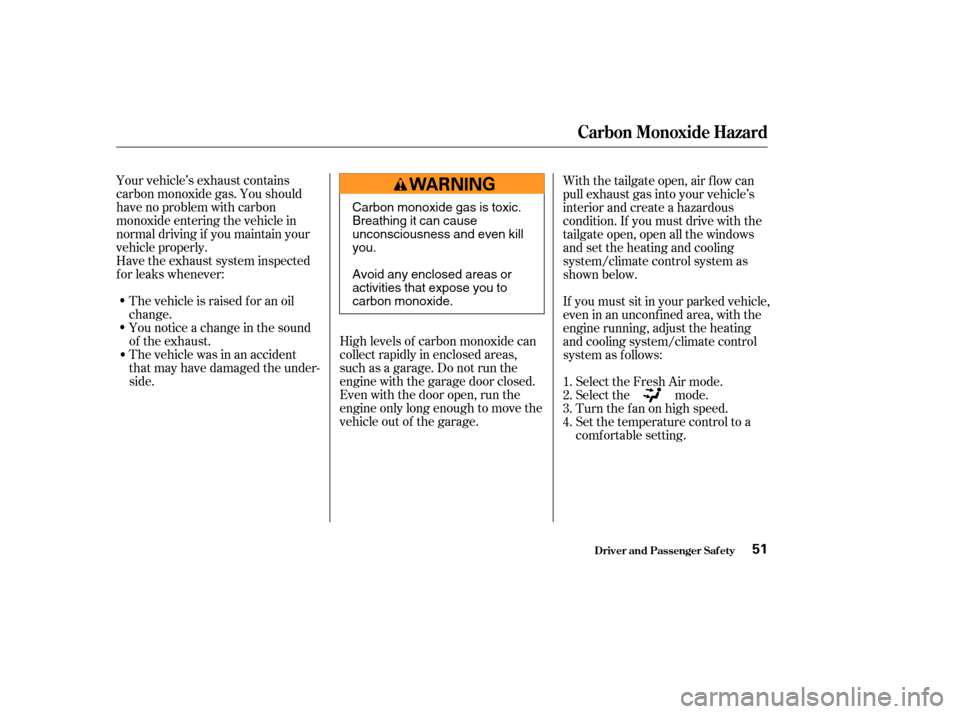
Your vehicle’s exhaust contains
carbon monoxide gas. You should
have no problem with carbon
monoxide entering the vehicle in
normal driving if you maintain your
vehicle properly.
Have the exhaust system inspected
f or leaks whenever:The vehicle is raised f or an oil
change.
You notice a change in the sound
of the exhaust.
The vehicle was in an accident
that may have damaged the under-
side. High levels of carbon monoxide can
collect rapidly in enclosed areas,
such as a garage. Do not run the
engine with the garage door closed.
Even with the door open, run the
engine only long enough to move the
vehicle out of the garage. With the tailgate open, air flow can
pull exhaust gas into your vehicle’s
interior and create a hazardous
condition. If you must drive with the
tailgate open, open all the windows
and set the heating and cooling
system/climate control system as
shown below.
If you must sit in your parked vehicle,
even in an unconf ined area, with the
engine running, adjust the heating
and cooling system/climate control
system as f ollows:
Select the Fresh Air mode.
Select the mode.
Turn the f an on high speed.
Set the temperature control to a
comfortable setting.
1.
2.
3.
4.
Carbon Monoxide Hazard
Driver and Passenger Saf ety51
Carbon monoxide gas is toxic.
Breathing it can cause
unconsciousness and even kill
you.
Avoid any enclosed areas or
activities that expose you to
carbon monoxide.
Page 56 of 284
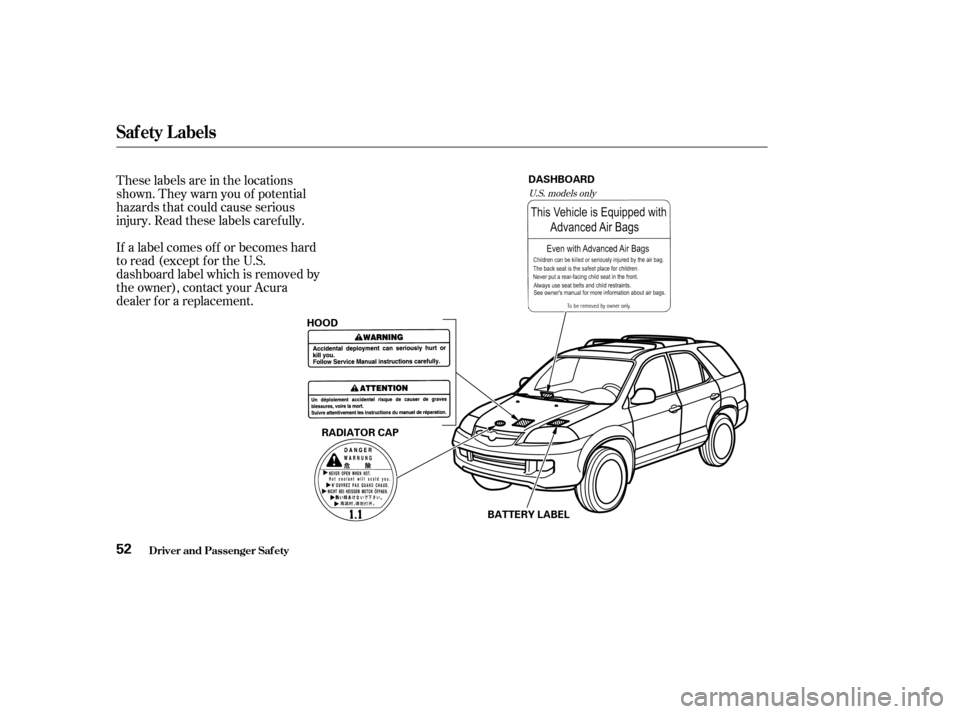
These labels are in the locations
shown. They warn you of potential
hazards that could cause serious
injury. Read these labels caref ully.
If a label comes of f or becomes hard
to read (except for the U.S.
dashboard label which is removed by
the owner), contact your Acura
dealer f or a replacement.U.S. models only
Saf ety L abels
Driver and Passenger Saf ety52
RADIATOR CAP
HOOD DASHBOARD
BATTERY LABEL
Page 57 of 284

U.S. modelsCanadian models Canadian models
U.S. models
On vehicles with side curtain airbags
Saf ety L abels
Driver and Passenger Saf ety53
SUN VISOR
DOORJAMBS
Page 58 of 284

54
Page 59 of 284
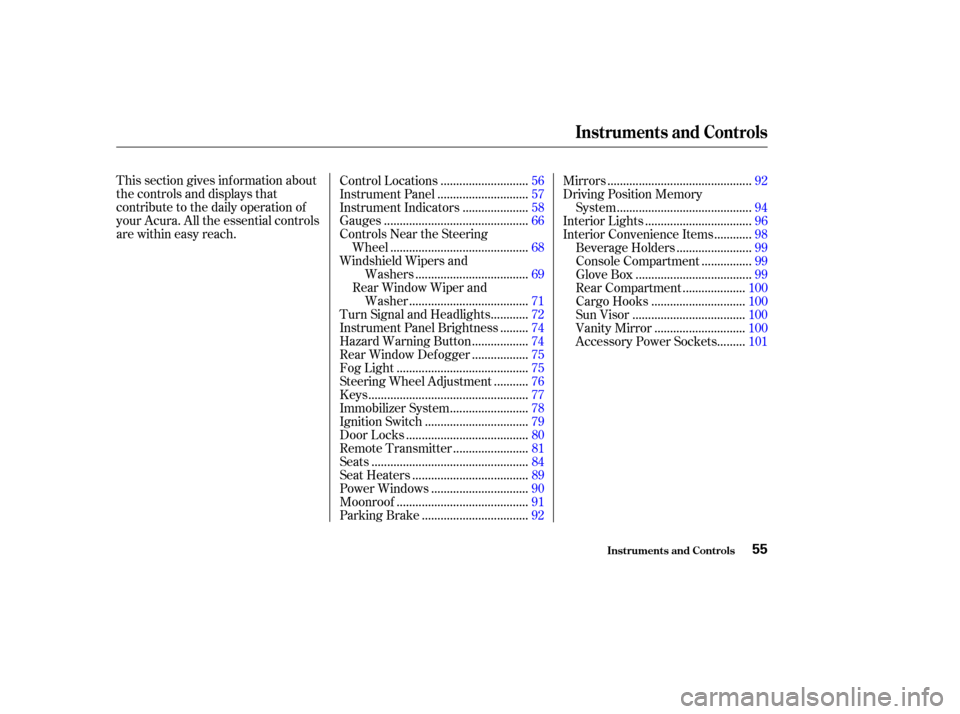
This section gives inf ormation about
the controls and displays that
contribute to the daily operation of
your Acura. All the essential controls
are within easy reach............................
Control Locations .56
............................
Instrument Panel .57
....................
Instrument Indicators .58
.............................................
Gauges .66
Controls Near the Steering ...........................................
Wheel .68
Windshield Wipers and ...................................
Washers .69
Rear Window Wiper and .....................................
Washer .71
...........
Turn Signal and Headlights . 72
........
Instrument Panel Brightness . 74
.................
Hazard Warning Button . 74
.................
Rear Window Def ogger . 75
.........................................
Fog Light .75
..........
Steering Wheel Adjustment . 76
..................................................
Keys .77
........................
Immobilizer System .78
................................
Ignition Switch .79
......................................
Door Locks .80
.......................
Remote Transmitter .81
.................................................
Seats .84
....................................
Seat Heaters .89
..............................
Power Windows .90
.........................................
Moonroof .91
.................................
Parking Brake .92 .............................................
Mirrors .92
Driving Position Memory ..........................................
System .94
.................................
Interior Lights .96
...........
Interior Convenience Items . 98
.......................
Beverage Holders .99
...............
Console Compartment . 99
....................................
Glove Box .99
...................
Rear Compartment . 100
.............................
Cargo Hooks .100
...................................
Sun Visor .100
............................
Vanity Mirror .100
........
Accessory Power Sockets . 101
Inst rument s and Cont rols
Instruments and Controls
55
Page 60 of 284
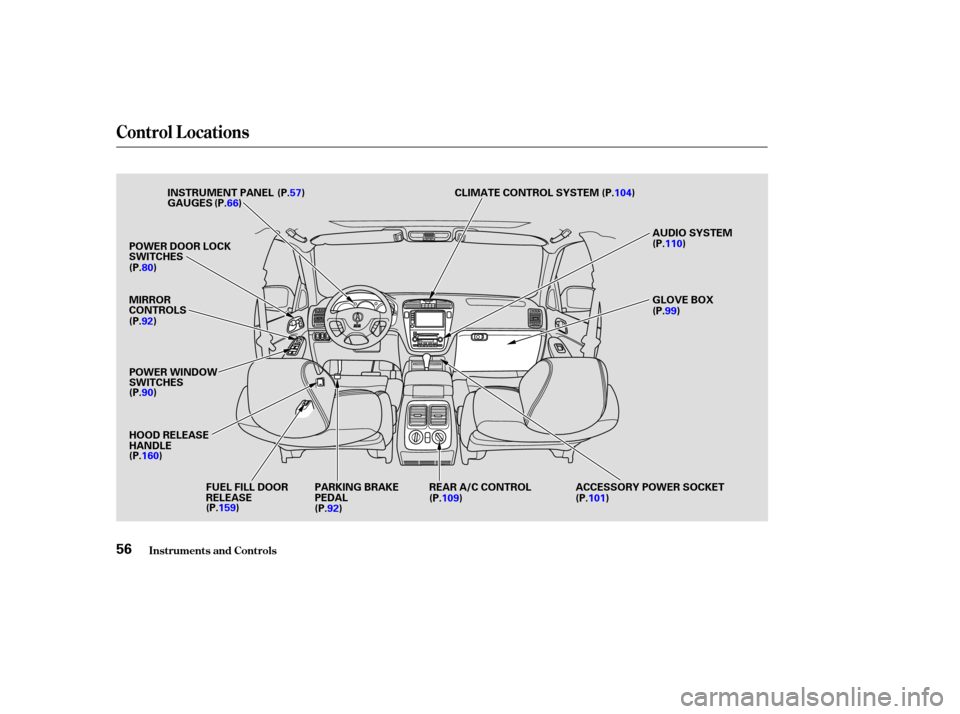
Control L ocations
Inst rument s and Cont rols56
MIRROR
CONTROLS
HOOD RELEASE
HANDLEPARKING BRAKE
PEDALREAR A/C CONTROL ACCESSORY POWER SOCKET GLOVE BOX AUDIO SYSTEM
CLIMATE CONTROL SYSTEM
GAUGES
POWER DOOR LOCK
SWITCHES
POWER WINDOW
SWITCHES FUEL FILL DOOR
RELEASE
INSTRUMENT PANEL (P.
57)
(P.66)
(P.80)
(P.92)
(P.90)
(P.160) (P.159) (P.92) (P.109)
(P.101)(P.110)
(P.99)
(P.104)